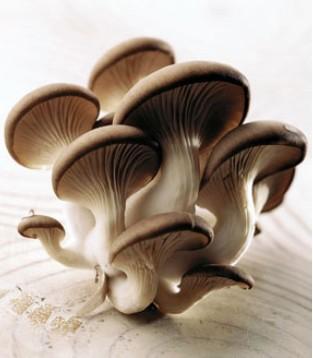
Science and Technology Bioremediation Bottom feeders
科技 生物降解 "清道夫"平菇
A novel way of dealing with an unpleasant problem
解決煩人難題的新穎方法
DESPITE their name, disposable nappies are notoriously difficult to dispose of.
一次性尿布,雖然它名字的英文含義為"可隨意處理的",然而對它的處理卻是一個老大難問題。
Studies of landfills suggest they may take centuries to rot away.
垃圾填埋區的研究顯示它們可能要花上幾個世紀才會完全腐爛。
But Alethia Vazquez-Morillas of the Autonomous Metropolitan University in Mexico City thinks she has found a method of speeding the process up.
但墨西哥城自治都市大學的阿萊蒂婭·巴斯克斯·莫萊拉絲(Alethia Vazquez-Morillas )認為她已經找到加速此過程的方法。
As she and her colleagues describe in Waste Management, cultivating the right type of mushroom on soiled nappies can break down 90% of the material they are made of within two months.
正如她與其同事在《廢物處理》一文中所描述,以尿布為基壤,培植恰當種類的菇類,能在兩個月內將其分解90%。
Within four, they are degraded completely.
四個月后,它們將被完全降解。
What is more, she says, despite their unsavoury diet the fungi in question, Pleurotus ostreatus (better known as oyster mushrooms), are safe to eat.
她表示,盡管所討論的糙皮側耳(即熟知的平菇)口味不佳,但食用安全。
To prove the point she has, indeed, eaten them.
為了證明這一點,她確確實實曾親口品嘗過。
The culinary use of oyster mushrooms was one reason why she picked them for the experiment.
平菇的食用價值正是她選擇其進行實驗的原因之一。
The species is frequently used in stir-fries and is often added to soups.
該食材經常用于煎炸以及常常被添加至湯中。
The other reason was that Pleurotus ostreatus is widely used in what is known as mycoremediation—the deployment of fungi to clean up waste.
而另一個原因是平菇被廣泛用于所謂的"茵核降解"(mycoremediation)——即是使用真菌去清理垃圾。
It is, for example, already grown on agricultural materials such as wheat and barley straw, and industrial waste like coffee grounds and the leftovers from making tequila.
比方說,它已經在處理諸如小麥和大麥秸稈等農業廢料以及在類似咖啡渣和特基拉酒廢渣等工業廢料上得到逐步推廣。
Dr Vazquez-Morillas and her colleagues were trying to extend the oyster mushroom's own culinary range.
巴斯克斯·莫萊拉絲博士與其同事正試圖拓展平菇原有的烹飪范圍。
The reason nappies are difficult to break down has nothing to do with their use.
尿布難于降解跟它有沒有被使用過毫無關系。
Even a clean nappy would hang around for a long time in a dump.
即便是干凈的尿布也會在垃圾場長期留存。
The main ingredient of a nappy is cellulose, an annoyingly persistent material.
尿布的主要組成部分是纖維素,它是一種煩人的頑固性物質。
Pleurotus, however, grows on dead or dying trees in the wild and is thus well provided with enzymes that break cellulose down.
然而在野外生長在已死或將死樹木上的平菇,將恰如其分地分泌出能分解纖維素的酶。
And, since Mexicans alone throw away 5 billion nappies every year, there is plenty of material from this source for them to get their mycelia into.
而且,既然僅墨西哥每年就有50億張尿布被丟棄,那么必定有大量此類原料正等著它們的菌絲去分解。
The idea that the result might be sold and eaten may be controversial but it is not absurd.
銷售并食用"尿布平菇"的想法或許具有爭議性,但卻并不荒唐。
The nappies the researchers used were contaminated only with urine, not faeces.
研究人員使用的尿布僅有尿漬,并沒有糞便。
A healthy person's urine is sterile and Dr Vazquez-Morillas also treated the nappies with steam, to make sure.
健康人類的尿液是無菌的,而巴斯克斯·莫萊拉絲博士也對尿布進行了蒸汽高溫消毒以確保安全。
Such treatment would kill the nasty bugs in faeces, too, though, so mushrooms grown on treated nappies should, in theory, be safe to eat.
這樣的處理也將殺死糞便中的骯臟蟲子,如果有的話,因此生長處理過的尿布上的平菇在理論上應該是可以安全食用。
In practice, overcoming the yuck factor might be an insuperable barrier to marketing nappy-grown fungi, and the cost of the steam treatment could make the exercise futile.
實際上,對于銷售長在尿布上的平菇而言,克服這種主觀上令人反感的因素或許是一道不可逾越的障礙,而且蒸汽高溫消毒的花銷可能是不切實際的。
Mycoremediation of this sort does not, however, depend for its success on selling the results.
然而,此類"茵核降解"的成功之處并不依賴于銷售其產物。
Merely getting rid of what would otherwise hang around indefinitely is worthwhile.
僅僅是擺脫那些難處理的廢物就物有所值了,不然的話那些垃圾可就要無限期地困擾我們了。
And of the fungi themselves, Dr Vazquez-Morillas observes, "they are cleaner than most of the vegetables you can find in the market, at least in Mexico."
而且對于這些菌類本身,巴斯克斯·莫萊拉絲博士評論道,"至少在墨西哥,它們要比你在市場上能找得到的大多數蔬菜干凈得多。"











